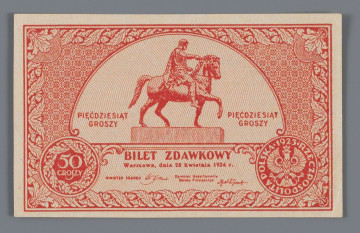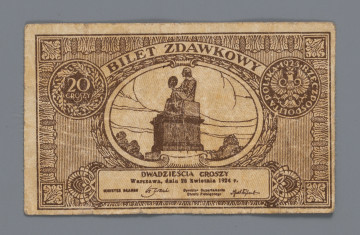
50 groshes [Polish: grosze]
1924
National Museum in Lublin
Part of the collection: Paper money during the Second Polish Republic
The main reason for the introduction of pass tickets in 1924 was the lack of low-denomination coins. The decision to introduce a new currency – the Polish zloty – was one of the elements of the so-called Grabski reform aimed at improving Poland's economic situation. The still-perceptible legacy of the partitions and the military effort undertaken to preserve the recently regained independence had led to economic collapse. For the average Polish citizen, but also for the economy, its most noticeable aspect was inflation. Problems with the formation of a government determined to undertake the work of reform, and then the haste that accompanied the introduction of the necessary changes, resulted in the need to resort to temporary solutions. The exchange of the hitherto circulating Polish marks into zlotys was scheduled for 28 April 1924, while the opening of the State Mint, which was to supply the coins, took place on 14 April. For obvious reasons, the Mint was not able to cover the market demand for coins, not only pennies but also zlotys, within a span of just two weeks. To remedy the unfavourable situation, it was decided to introduce replacement tickets into circulation. They were to remain in circulation only temporarily, and the beginning of their withdrawal from the market was set for 1 November 1924. In the case of one- and five-groszy denominations, Polish marks withdrawn from circulation were reused for this purpose. To adapt them to the new functions, the banknotes were cut and a red overprint showing the existing denomination was put on them together with an image of the replaced coin and information on its legal basis. In the case of the one-penny tickets, the 500,000-mark banknotes which had not entered into circulation were used, while the five-penny tickets were created by overprinting the 10,000,000-mark banknotes. In contrast to the one-penny notes, new banknotes without series or numbering were used. In contrast to the single-penny banknotes, the new banknotes were not marked with series and numbers. In fact, all 5-penny banknotes in circulation were between 102 and 107 mm long, slightly more than half the length of the second banknote used (the presented example is 104 mm long).
Leszek Poniewozik
Author / creator
Dimensions
cały obiekt: height: 104 mm, width: 91 mm
Object type
paper money
Technique
Material
paper
Creation time / dating
Creation / finding place
Owner
The National Museum in Lublin
Identification number
Location / status

1924
National Museum in Lublin

1924
National Museum in Lublin

1924
National Museum in Lublin
DISCOVER this TOPIC
National Museum in Lublin
DISCOVER this PATH
Educational path